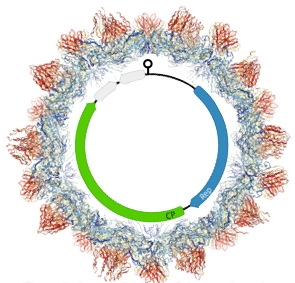Extreme Viruses,
Extreme Science
Our research focuses on viruses found in the extreme environment of volcanic acid hot springs. Because it is presumed that the earliest life lived under similar conditions, studying these viruses can help inform viral evolution, and the evolution of all of life itself.
One main area of study for our lab focuses on the thermoacidophilic archaeon Saccharolobus (previously called Sulfolobus) and related viruses. These viruses are completely different, both in physical capsid structure and genome composition, from almost any other known viruses.
How do they and their hosts function at such high temperatures (80º C /176º F) and high acidity (pH below 4)? Why are these viruses so unique? What can they teach us about the evolution of other viruses, life on earth, and even life beyond earth? The Stedman Lab uses genetic, genomic, structural and biochemical tools to answer these questions and more about these enigmatic viruses.
"Stanley", our 3D printed model of an SSV1, in front of Chinoike Jigoku. Translating to Blood Pond Hell, this geothermal hot spring in Beppu, Japan is where the first SSV was discovered. It is only one of the geothermal hot springs around the world where many more SSVs and similar viruses have been found.
Genome and hypothetical structure of a crucivirus
We discovered a completely new group of viruses in a hot acidic lake that appears to have formed by an unprecedented RNA-DNA recombination event. We are only beginning to learn about how widespread and diverse these "cruciviruses" really are.
The silified egg of Trichuris suis under a scanning electron microscope (SEM).
While looking for virus fossils, we also discovered a way to reversibly inactivate viruses, which may revolutionize vaccine formulation, potentially saving millions of lives. With a grant from the Gates Foundation, we are also researching how to use this technology to preserve the eggs of intestinal parasites, used for field diagnosis. We are also looking at silver nanoparticles as a new kind of broad spectrum antiviral.
News + Publications
Find out what's new in the Stedman Lab by visiting our blog!
LAND ACKNOWLEDGEMENT
The Extreme Virus Group is located at Portland State University in downtown Portland, Oregon in Multnomah County. We honor the Indigenous people whose traditional and ancestral homelands we have the privilege to work on, the Multnomah, Kathlamet, Clackamas, Tumwater, Watlala bands of the Chinook, the Tualatin Kalapuya and many other indigenous nations of the Columbia River. It is important to acknowledge the ancestors of this place and to recognize that we are here because of the sacrifices forced upon them. In remembering these communities, we honor their legacy, their lives, and their descendants.



